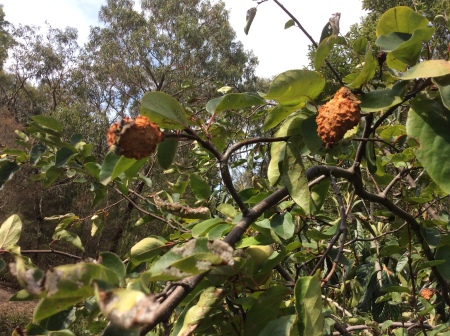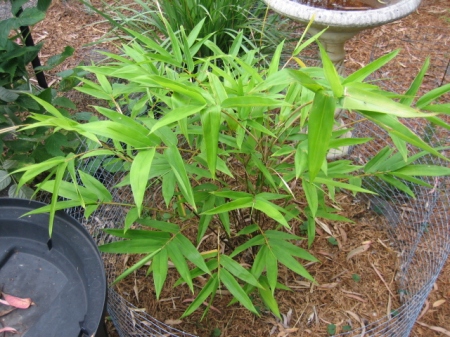Well, summer is officially over, but the weather remained warm all through March, with temperatures in the high 20’s and sometimes nudging into the low 30’s.
I’ve pulled out most of the tomatoes—the plants looked awful, with dead, shrivelled lower leaves, extending upwards in some cases. Surprisingly, yields were pretty good, especially of the cherries, but then there were more plants of those than the bigger varieties. I didn’t bother to dry any cherries, but instead froze a large box of them, to use for winter soups and casseroles. There’s still one self-sown plant going well in a wicking box down the back, just starting to bear fruits.
I picked 2 more eggplants and there are still 3 on the plants plus a couple more flowers which may produce fruits. I’ll definitely grow these again next season. Six fruits from 3 plants wasn’t a bad effort for a first-time growing :
I decided to try peas in a ‘tepee’. It’s worked well for beans in the past. These are a tall, purple-podded variety. They germinated well….. :
…..and after a week or so I put up the supporting strings for them to climb on :
I’ve put more peas in a wicking box. These are a short-stemmed variety which have a lot of tendrils so they hang onto each other. I’ll just put 4 stakes in the corners of the box with a string around them to keep the whole bunch from falling over and that should do. The tiny seedlings are self-sown chickweed which the chooks will get eventually :
I may get some pumpkins this year. There are 2 on this plant. With any luck they’ll get big enough to ripen before the weather breaks:
Capsicums, sharing a wicking box with climbing beans, are fruiting :
The prize for the top-bearing plants this season would have to go to the 5 thornless blackberry plants I put in 2 years ago. At the height of the season I was picking a small handful of delicious berries every couple of days. I decided I would definitely get more bare-rooted plants from my local nursery this winter and then discovered Bunnings had them for sale in small pots. They’re a Nelly Kelly variety :
I’ve put one in a large tub beside the deck and will train it up onto the deck :
I haven’t decided where to plant the second one yet. I didn’t keep the tag of the original plants and think they were just called ‘thornless blackberries’, without a variety name. They were just pencil-sized, bare-rooted stems when I planted them. These Nelly Kelly varieties have thin little stems and small leaves. Maybe that’s just due to being young plants in pots. It will be interesting to see how they turn out.
It’s been a good year for pepinos :
The new season’s silver beet is also bearing well in a wicking box :
I had a wicking box on the deck with Gotu Kola (Centella asiatica) in it. Also known as arthritis plant, it’s native to Asia and is reputed to cure many ills as well as arthritis. I intended to use it to make a herbal tea, but didn’t like the bitter flavour and so it wasn’t used much. I planted a pepino in there to keep it company. A self-sown alpine strawberry also appeared :

The pepino grew well and produced several fruits but eventually got big and woody and I hacked it back, not caring whether it sprouted again or not, because I had others in the garden. It didn’t…..and the gotu kola took over. I trimmed it back occasionally but generally ignored it. Finally, it occurred to me that the wicking box was just being wasted and I’d be better to plant it with something I would actually use.
So, I tipped it on its side and then upended it :
As I suspected, the bottom half of the soil mixture was bone dry and the roots in it were dead. I’d been watering it every day, but the water was running out of the drainage holes before it was able to soak into the soil and saturate the lower reservoir. The plant had been living on its daily drink. The box just had too much growth in it.
The dry soil was friable and worth saving. There had been worms in it and they’d either died or moved on, so it was likely most of the soil would be worm castings. I broke it up with the spade and sieved it :
I got a large tub of soil that will be useful as a seed-raising mix :
I filled the wicking box with new compost and sowed seeds of mizuna, a fast-growing Asian green, which both I and the chooks like :
A few weeks later and it looked like this :
The grassy stuff is wheat. The chooks don’t eat the wheat in their grain mix and wherever I use the chook poo compost made with the floor sweepings from their run, I get wheat germinating. I decided to leave it there. The chooks will only eat wheat if it’s sprouted first, so it makes some sense to grow it for them for sprouting. I used to grow it years ago, but gave up when the parrots kept raiding the ears while they were green. Because there are still cabbage white butterflies about (and will be, until the weather gets colder), I’ve had to put a cover over the box to prevent the female butterflies laying eggs on the mizuna :
Mosquito netting is the only thing that will keep the butterflies out. I’ve always used half-inch netting in the past but was stunned to see a butterfly fold her wings back and actually squeeze through it. So now I have a (relatively) new wicking box with a more useful crop.
I planted garlic on the equinox. Only a few cloves have sprouted—not worth a photo. I’ve failed dismally with garlic the last couple of years, but I still keep trying. Last year the plants rotted away in winter; the year before that they didn’t produce any bulbs. I’ve had good garlic in the past—don’t know what I’m doing wrong. I felt a bit better when my Italian neighbours told me their garlic has failed too—if Italians can’t grow garlic, there must be something more at work than my own incompetence.
I tend to divide my growing year into 2 seasons—spring/summer (October-March) and autumn/winter (April-September) and always grow more food in the spring/summer season. In total, in the season just finished, I managed to grow about 30 varieties of food, including more than a dozen different fruits; 6 greens; 4 root crops; onions and leeks and asparagus, plus a variety of herbs. Oh, and eggs (the Girls helped with those). There wasn’t a huge amount of anything (except maybe tomatoes), but I’m aiming for diversity anyway. Pretty happy with what I’m able provide for myself.
We had 37 mm rainfall in March; 32 mm in the 3rd week and 5 mm in the final week. Melbourne’s average is 44 mm. Let’s hope the warm weather and rain continues through autumn.
Postscript
Those thornless blackberries from Bunnings—
I went out to take a few more pics for this post and noticed that the blackberry I put in the large tub by the deck had a flower on it :
It’s white! The other thornless blackberries I bought at the local nursery had pink flowers :
So there is a difference. I think I need to do some research on thornless blackberries. As I understand it, they’re hybrids of the normal blackberry with something else. Something else what? The first 5 plants I put in have had really good yields. I hope these 2 new varieties are as good.
















































































































































